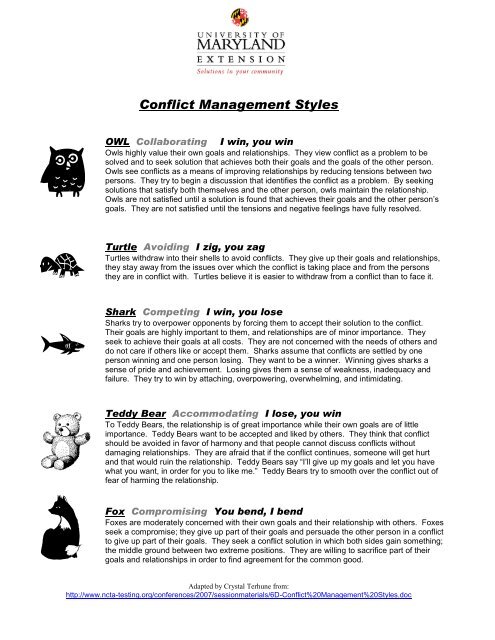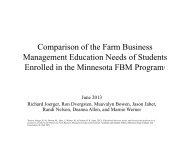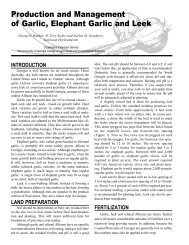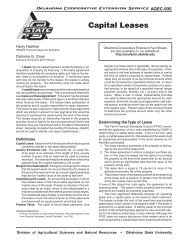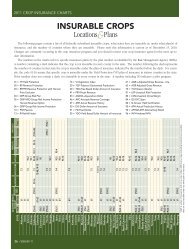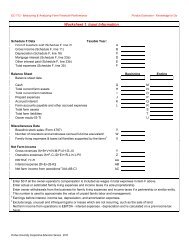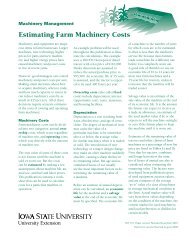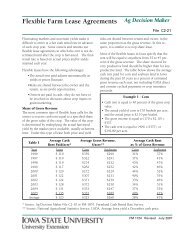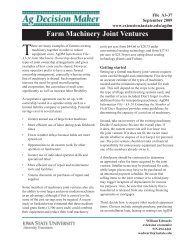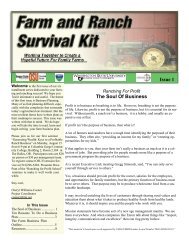Conflict Management Styles - National Ag Risk Education Library
Conflict Management Styles - National Ag Risk Education Library
Conflict Management Styles - National Ag Risk Education Library
You also want an ePaper? Increase the reach of your titles
YUMPU automatically turns print PDFs into web optimized ePapers that Google loves.
<strong>Conflict</strong> <strong>Management</strong> <strong>Styles</strong><br />
OWL Collaborating I win, you win<br />
Owls highly value their own goals and relationships. They view conflict as a problem to be<br />
solved and to seek solution that achieves both their goals and the goals of the other person.<br />
Owls see conflicts as a means of improving relationships by reducing tensions between two<br />
persons. They try to begin a discussion that identifies the conflict as a problem. By seeking<br />
solutions that satisfy both themselves and the other person, owls maintain the relationship.<br />
Owls are not satisfied until a solution is found that achieves their goals and the other person’s<br />
goals. They are not satisfied until the tensions and negative feelings have fully resolved.<br />
Turtle Avoiding I zig, you zag<br />
Turtles withdraw into their shells to avoid conflicts. They give up their goals and relationships,<br />
they stay away from the issues over which the conflict is taking place and from the persons<br />
they are in conflict with. Turtles believe it is easier to withdraw from a conflict than to face it.<br />
Shark Competing I win, you lose<br />
Sharks try to overpower opponents by forcing them to accept their solution to the conflict.<br />
Their goals are highly important to them, and relationships are of minor importance. They<br />
seek to achieve their goals at all costs. They are not concerned with the needs of others and<br />
do not care if others like or accept them. Sharks assume that conflicts are settled by one<br />
person winning and one person losing. They want to be a winner. Winning gives sharks a<br />
sense of pride and achievement. Losing gives them a sense of weakness, inadequacy and<br />
failure. They try to win by attaching, overpowering, overwhelming, and intimidating.<br />
Teddy Bear Accommodating I lose, you win<br />
To Teddy Bears, the relationship is of great importance while their own goals are of little<br />
importance. Teddy Bears want to be accepted and liked by others. They think that conflict<br />
should be avoided in favor of harmony and that people cannot discuss conflicts without<br />
damaging relationships. They are afraid that if the conflict continues, someone will get hurt<br />
and that would ruin the relationship. Teddy Bears say “I’ll give up my goals and let you have<br />
what you want, in order for you to like me.” Teddy Bears try to smooth over the conflict out of<br />
fear of harming the relationship.<br />
Fox Compromising You bend, I bend<br />
Foxes are moderately concerned with their own goals and their relationship with others. Foxes<br />
seek a compromise; they give up part of their goals and persuade the other person in a conflict<br />
to give up part of their goals. They seek a conflict solution in which both sides gain something;<br />
the middle ground between two extreme positions. They are willing to sacrifice part of their<br />
goals and relationships in order to find agreement for the common good.<br />
Adapted by Crystal Terhune from:<br />
http://www.ncta-testing.org/conferences/2007/sessionmaterials/6D-<strong>Conflict</strong>%20<strong>Management</strong>%20<strong>Styles</strong>.doc
<strong>Conflict</strong>-<strong>Management</strong> Style<br />
In this section you will have the opportunity to examine your own conflict-management<br />
style and techniques you tend to use in conflict situations, particularly under stress. The<br />
exercises that follow will enable you to gain insight in to strategies you might choose to<br />
incorporate into your behavior in handling disputes and differences.<br />
<strong>Conflict</strong>-<strong>Management</strong> Style Survey*<br />
This <strong>Conflict</strong>-<strong>Management</strong> Style Survey has been designed to help you become more<br />
aware of your characteristic approach, or style, in managing conflict. In completing this survey,<br />
you are invited to respond by making choices that correspond with you typical behavior or<br />
attitudes in conflict situations.<br />
Section 1: Survey<br />
This survey identifies twelve situations that you are likely to encounter in your personal<br />
and professional lives. Please study each situation and the five possible behavioral responses or<br />
attitudes carefully and then allocate ten points between them to indicate your typical behavior,<br />
with the highest number of points indicating you strongest choice. Any response can be<br />
answered with from zero to ten points, as long as all five responses for a given situation add up<br />
to ten points, as shown in the following example:<br />
EXAMPLE SITUATION: In responding to a request from another for help with a problem, you<br />
would:<br />
4 A. Clearly instruct him or her how to proceed.<br />
2 B. Enjoy the strategizing and the challenge.<br />
3 C. Help him or her take responsibility for the problem.<br />
1 D. Find it unnerving but agree to help.<br />
0 E. Avoid the invitation at all costs.<br />
10 TOTAL<br />
Please choose a single frame of reference (e.g., work-related conflicts, family conflicts,<br />
social conflicts) and keep that frame of reference in mind when responding to all the situations.<br />
And remember, as you complete this survey, that it is not a test. There are no right or wrong<br />
responses. They survey will be helpful to you only to the extent that your responses accurately<br />
represent your characteristic behavior or attitudes.<br />
SITUATION 1: Upon experiencing strong feelings in a conflict situation, you would:<br />
_____ A. Enjoy the emotional release and sense of exhilaration and accomplishment.<br />
_____ B. Enjoy the strategizing involved and the challenge of the conflict.<br />
_____ C. Become serious about how others are feeling and thinking.<br />
_____ D. Find it frightening because you do not accept that differences can be<br />
discussed without someone’s getting hurt.<br />
_____ E. Become convinced that there is nothing you can do to resolve the issue.<br />
TOTAL<br />
*Based on Jay Hall’s <strong>Conflict</strong> <strong>Management</strong> Survey: A Survey of One’s Characteristic Reaction to and Handling of <strong>Conflict</strong> Between Himself and<br />
Others (The Woodlands, Texas: Telemetrics International 1969)><br />
The Leadership Center At Washington State University<br />
D:\My Documents\Websites\lead\library\resources\RESOURCES\<strong>Conflict</strong> Resolution\<strong>Conflict</strong>-<strong>Management</strong> Style.doc<br />
1
SITUATION 2: Consider the following statements and rate them in terms of how characteristic<br />
they are of your personal beliefs:<br />
_____ A. Life is conquered by those who believe in winning.<br />
_____ B. Winning is rarely possible in conflict.<br />
_____ C. No one has the final answer to anything, but each has a piece to contribute.<br />
_____ D. In the last analysis, it is wise to turn the other cheek.<br />
_____ E. It is useless to attempt to change a person who seems locked into an<br />
opposing view.<br />
TOTAL<br />
SITUATION 3: What is the best result that you expect from conflict?<br />
_____ A. <strong>Conflict</strong> helps people face the fact that one answer is better than others.<br />
_____ B. <strong>Conflict</strong> results in canceling out extremes of thinking so that a strong middle<br />
ground can be reached.<br />
_____ C. <strong>Conflict</strong> clears the air and enhances commitment and results.<br />
_____ D. <strong>Conflict</strong> demonstrates the absurdity of self-centeredness and draws people<br />
closer together in their commitment to each other.<br />
_____ E. <strong>Conflict</strong> lessens complacency and assigns blame where it belongs.<br />
TOTAL<br />
STIUATION 4: When you are the person with the greater authority in a conflict situation, you<br />
would:<br />
_____ A. Put it straight, letting the other know your view.<br />
_____ B. Try to negotiate the best settlement you can get.<br />
_____ C. Ask to hear the other’s feelings and suggest that a position be found that<br />
both might be willing to try.<br />
_____ D. Go long with the other, providing support where you can.<br />
_____ E. Keep the encounter impersonal, citing rules if they apply.<br />
TOTAL<br />
SITUATION 5: When someone you care for takes an unreasonable position, you would:<br />
_____ A. Lay it on the line, telling him or her that you don’t like it.<br />
_____ B. Let him or her know in casual, subtle ways that you are not pleased; possibly<br />
distract with humor; and avoid a direct confrontation.<br />
_____ C. Call attention to the conflict and explore a mutually acceptable solution.<br />
_____ D. Try to keep your misgivings to yourself.<br />
_____ E. Let you actions speak for you by indicating depression or lack of interest.<br />
TOTAL<br />
SITUATION 6: When you become angry at a friend or colleague, you would:<br />
_____ A. Just explode without giving it much thought.<br />
_____ B. Try to smooth things over with a good story.<br />
_____ C. Express your anger and invite him or her to respond.<br />
_____ D. Try to compensate for your anger by acting the opposite of what you are<br />
feeling.<br />
_____ E. Remove yourself from the situation.<br />
TOTAL<br />
The Leadership Center At Washington State University<br />
D:\My Documents\Websites\lead\library\resources\RESOURCES\<strong>Conflict</strong> Resolution\<strong>Conflict</strong>-<strong>Management</strong> Style.doc<br />
2
SITUATION 7: When you find yourself disagreeing with other members of a group on an<br />
important issue, you would:<br />
_____ A. Stand by your convictions and defend your position.<br />
_____ B. Appeal to the logic of the group in the hope of convincing at least a majority<br />
that you are right.<br />
_____ C. Explore points of agreement and disagreement and the feelings of the<br />
group’s member, and then search for alternatives that take everyone’s views<br />
into account.<br />
_____ D. Go along with the rest of the group.<br />
_____ E. Not participate in the discussion and not feel bound by any decision reached.<br />
TOTAL<br />
SITUATION 8: When a single group member takes a position in opposition to the rest of the<br />
group, you would:<br />
_____ A. Point out publicly that the dissenting member is blocking the group and<br />
suggest that the group move on without him or her if necessary.<br />
_____ B. Make sure the dissenting member has a chance to communicate his or her<br />
objections so that a compromise can be reached.<br />
_____ C. Try to uncover why the dissenting member views the issue differently, so<br />
that the group’s members can reevaluate their own positions.<br />
_____ D. Encourage the group’s members to set the conflict aside and go on to more<br />
agreeable items on the agenda.<br />
_____ E. Remain silent, because it is best to avoid becoming involved.<br />
TOTAL<br />
SITUATION 9: When you see conflict emerging in a group, you would:<br />
_____ A. Push for a quick decision to ensure that the task is completed.<br />
_____ B. Avoid outright confrontation by moving the discussion toward a middle<br />
ground.<br />
_____ C. Share with the group your impression of what is going on, so that the nature<br />
of the impending conflict can be discussed.<br />
_____ D. Forestall or divert the conflict before it emerges by relieving the tension with<br />
humor.<br />
_____ E. Stay out of the conflict as long as it is of no concern to you.<br />
TOTAL<br />
SITUATION 10: In handling conflict between your group and another, you would:<br />
_____ A. Anticipate areas of resistance and prepare responses to objections prior to<br />
open conflict.<br />
_____ B. Encourage your group’s members to be prepared by identifying in advance<br />
areas of possible compromise.<br />
_____ C. Recognize that conflict is healthy and press for the identification of shared<br />
concerns and/or goals.<br />
_____ D. Promote harmony on the grounds that the only real result of conflict is the<br />
destruction of friendly relations.<br />
_____ E. Have your group submit the issue to an impartial arbitrator.<br />
TOTAL<br />
The Leadership Center At Washington State University<br />
D:\My Documents\Websites\lead\library\resources\RESOURCES\<strong>Conflict</strong> Resolution\<strong>Conflict</strong>-<strong>Management</strong> Style.doc<br />
3
SITUATION 11: In selecting a member of your group to represent you in negotiating with<br />
another group, you would choose a person who:<br />
_____ A. Knows the rationale of your group’s position and would press vigorously for<br />
your group’s point of view.<br />
_____ B. Would see that most of your group’s judgments were incorporated into the<br />
final negotiated decision without alienating too many members of either<br />
group.<br />
_____ C. Would best represent the ideas of your group, evaluate these in view of<br />
judgments of the other group, and then emphasize problem-solving<br />
approaches to the conflict.<br />
_____ D. Is most skillful in interpersonal relations and would be openly cooperative<br />
and tentative in his or her approach.<br />
_____ E. Would present your group’s case accurately, while not making commitments<br />
that might result in obligating your group to a significantly changed position.<br />
TOTAL<br />
SITUATION 12: In your view, what might be the reason for the failure of one group to<br />
collaborate with another?<br />
_____ A. Lack of a clearly stated position, or failure to back up the group’s position.<br />
_____ B. Tendency of groups to force their leadership or representatives to abide by<br />
the group’s decision, as opposed to promoting flexibility, which would<br />
facilitate compromise.<br />
_____ C. Tendency of groups to enter negotiations with a win/lose perspective.<br />
_____ D. Lack of motivation on the part of the group’s membership to live peacefully<br />
with the other group.<br />
_____ E. Irresponsible behavior on the part of the group’s leadership, resulting in the<br />
leaders’ placing emphasis on maintaining their own power positions rather<br />
than addressing the issues involved.<br />
TOTAL<br />
Section 2: Scoring<br />
Step 1<br />
When you have completed all items in Section 1, write the number of points you assigned for<br />
each of the five responses for the twelve situations in the appropriate columns on the scoring<br />
form (figure 26). Add the total number of points for each column, then check that the totals for<br />
each column add up to 120.<br />
Step 2<br />
Transfer your column total scores onto the form showing the ideal order (figure 27).<br />
Step 3<br />
Transfer the style names, in order of the highest score first, on the figure 28, which shows your<br />
order, and then enter the scores in the adjacent blank spaces.<br />
Step 4<br />
Record your scores in the appropriate blanks on the <strong>Conflict</strong>-<strong>Management</strong> <strong>Styles</strong> Scoring Graph<br />
(figure 29). (You may wish to refresh your memory by reviewing the material describing the<br />
five conflict styles presented earlier in the subsection entitled A Two-Dimensional Model of<br />
<strong>Conflict</strong>.)<br />
The Leadership Center At Washington State University<br />
D:\My Documents\Websites\lead\library\resources\RESOURCES\<strong>Conflict</strong> Resolution\<strong>Conflict</strong>-<strong>Management</strong> Style.doc<br />
4
Situation Response Response Response Response Response Total<br />
A B C D E<br />
1 10<br />
2 10<br />
3 10<br />
4 10<br />
5 10<br />
6 10<br />
7 10<br />
8 10<br />
9 10<br />
10 10<br />
11 10<br />
12 10<br />
TOTAL: 120<br />
Figure 26. Scoring form.<br />
STYLE Score<br />
1. Collaborator (Column C)<br />
2. Compromiser (Column B)<br />
3. Accommodator (Column D)<br />
4. Controller (Column A)<br />
5. Avoider (Column E)<br />
TOTAL:<br />
Figure 27. Ideal order.<br />
Choice Style Score<br />
1st<br />
2nd<br />
3rd<br />
4th<br />
5th<br />
TOTAL:<br />
Figure 28. Your order.<br />
The Leadership Center At Washington State University<br />
D:\My Documents\Websites\lead\library\resources\RESOURCES\<strong>Conflict</strong> Resolution\<strong>Conflict</strong>-<strong>Management</strong> Style.doc<br />
5
Competing/Controlling is assertive and uncooperative – an individual pursues his<br />
or her own concerns at the other person’s expense. This is a power-oriented mode,<br />
in which one uses whatever power seems appropriate to win one’s own position –<br />
one’s ability to argue, one’s rank, economic sanctions. Competing might mean<br />
“standing up for your rights,” defending a position which you believe is correct, or<br />
simply trying to win.<br />
Accommodating is unassertive and cooperative – the opposite of competing. When<br />
accommodating, an individual neglects his or her own concerns to satisfy the<br />
concerns of the other person; there is an element of self-sacrifice in this mode.<br />
Accommodating might take the form of selfless generosity or charity, obeying<br />
another person’s order when one would prefer not to, or yielding to another’s point<br />
of view.<br />
Avoiding is unassertive and uncooperative – the individual does not immediately<br />
pursue his own concerns or those of the other person. He or she does not address<br />
the conflict. Avoiding might take the form of diplomatically sidestepping an issue,<br />
postponing an issue until a better time, or simply withdrawing from a threatening<br />
situation.<br />
Collaborating is both assertive and cooperative – the opposite of avoiding.<br />
Collaborating involves an attempt to work with the other person to find some<br />
solution which fully satisfies the concerns of both persons. It means digging into<br />
an issue to identify the underlying concerns of the two individuals and to find an<br />
alternative which meets both sets of concerns. Collaborating between two persons<br />
might take the form of exploring a disagreement to learn from each other’s<br />
insights, concluding to resolve some condition which would otherwise have them<br />
competing for resources, or confronting and trying to find a creative solution to an<br />
interpersonal problem.<br />
Compromising is intermediate in both assertiveness and cooperativeness. The<br />
object is to find some expedient, mutually acceptable solution which partially<br />
satisfies both parties. It falls on a middle ground between competing an<br />
accommodating. Compromising gives up more than competing but less than<br />
accommodating. Likewise, it addresses an issue more directly than avoiding, but<br />
doesn’t explore it in as much depth as collaborating. Compromising might mean<br />
splitting the difference, exchanging concessions, or seeking a quick middle-ground<br />
position.<br />
The Leadership Center At Washington State University<br />
D:\My Documents\Websites\lead\library\resources\RESOURCES\<strong>Conflict</strong> Resolution\<strong>Conflict</strong>-<strong>Management</strong> Style.doc<br />
6
Concern<br />
10<br />
9<br />
8<br />
7<br />
6<br />
for 5<br />
relationships<br />
4<br />
3<br />
2<br />
1<br />
0<br />
Accommodator – 3<br />
(Yield-lose/win)<br />
*Score:____________<br />
• Low goal orientation<br />
• High relationships orientation<br />
Avoider – 5<br />
(Leave-lose/win)<br />
*Score:___________<br />
• Low goal orientation<br />
• Low relationships orientation<br />
Compromiser – 2<br />
(Mini-win/mini-lose)<br />
*Score:____________<br />
• Negotiated goal orientation<br />
• Negotiated relationships<br />
orientation<br />
Concern for personal goals<br />
Collaborator – 1<br />
(Win/win)<br />
*Score:____________<br />
• High goal orientation<br />
• High relationships orientation<br />
Controller – 4<br />
(Win/lose)<br />
*Score:____________<br />
• High goal orientation<br />
• Low relationships orientation<br />
1 2 3 4 5 6 7 8 9 10<br />
The Leadership Center At Washington State University<br />
D:\My Documents\Websites\lead\library\resources\RESOURCES\<strong>Conflict</strong> Resolution\<strong>Conflict</strong>-<strong>Management</strong> Style.doc<br />
7


